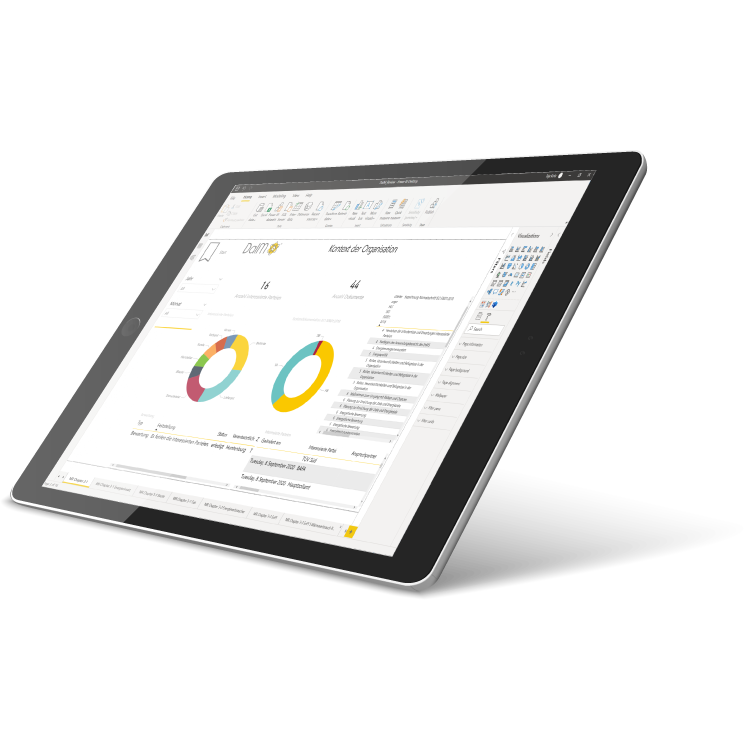Scope
Expectation
Site
Prozess
Context Management – Consistently capturing and tracking expectations of interested parties in the context of the organization
Defining the context of an organization is the starting point for a functioning management system.
DaIM facilitates scoping through integrated connection of the scope. This enables cost-efficient certification. In context management you have all internal and external changes under control.

Highlights
- Easy use of all expectations in one place
- Use framework conditions and not just capture them
- Reduce costs through precise scoping
- Harmonize scopes and certification scopes across standards
- Map documents and processes to the scope
- Match interested parties with existing CRM systems in the Common Data Model
- No redundancy of data
- Simple printing and reporting functions for necessary documented information
- Simplified communication with auditors and certification bodies
- Integrated SoA in information security management
- Communication regulated in the context of the organization
Scope
DaIM facilitates scoping through integrated connection of the scope. This enables cost-efficient certification.
Expectation
The expectations of interested parties are systematically recorded, evaluated, necessary actions delegated to the responsible employees and monitored to the central action management. Communication with interested parties is managed centrally. Internal and external issues are recorded and evaluated. Necessary actions can be tracked in the actions module.
Process
All management system processes are linked visually and data-based. Resources, key figures and interactions are mapped in an integrated manner in a process map.
Site
In the scope, processes, locations, buildings and work areas, system boundaries, counting points and exclusions are documented in an audit-proof manner. A statement is made regarding the applicability (SoA) of standard-specific requirements.
The core components of DaIM
App
A central app for communication and collaboration in Microsoft Teams. With the data-based implementation of all standard requirements, processing is possible anytime and anywhere.
Documents & Processes
Securely edit documented information and processes efficiently, approve and authorize effectively, and keep them linked to the DaIM App's protected data.
Connector
Efficient handling of existing data by connecting data sources based on hundreds of proven data connectors. Deep insights by integrating all relevant data from the enterprise across all standards.
Review
Real-time management review at the click of a mouse. Minimize the effort for recurring evaluations. Compare the results of your management reviews.
Digital Auditor & AI
AI is not only about certification readiness of your management systems, but also about changing the way your employees work. With the Digital Auditor and the Improvement Engine you transfer your management system approach into the digital age.
Audit Mining
Real-time management review at the click of a mouse. Minimize the effort for recurring evaluations. Compare the results of your management reviews.
Innovative Technologies
The functional fusion of leading collaboration tools makes DaIM unique and the most advanced management system in the world today.
Functions
Asset management
Complex asset management over the entire life cycle
Audit management
Planning, execution and reporting from a single source
Compliance management
Binding obligations and material evidence at a glance
Document management
Collaborative work and database-supported management of electronic documents
Incident management
Intuitive recording and seamless tracking of events
Hazardous materials management
Safe handling of hazardous materials through systematic processes
Maintenance management
Preventing malfunctions through efficient maintenance
Key figure management
Flexible key figure system for monitoring business processes
Context management
Identifying and anticipating the expectations of interested parties
Measures management
Centralized control of corrective and preventive measures from all sources
Means of measurement management
Mapping of means of measurement hierarchies and maintenance of means of measurement capability
Process management
Identification, visualization, documentation, control and optimization of business processes
Resource Management
Organization of competencies, authorities and tasks for management teams
Risk management
Monitoring opportunities and risks in an intelligent way
Training management
Demand-driven training organization and record keeping
Scopemanagement
Clearly define scopes and exclusions through transparent scoping


